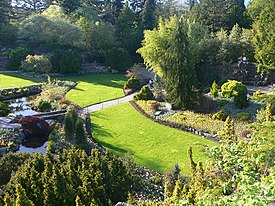Queen Elizabeth Park, British Columbia
| Queen Elizabeth Park | |
|---|---|

A view of the park
|
|
| Type | Public Park |
| Location | Vancouver, British Columbia, Canada |
| Created | 1939 |
| Operated by | City of Vancouver |
Queen Elizabeth Park is a 130-acremunicipal park located in Vancouver, British Columbia, Canada, on Little Mountain (elevation approximately 152 metres or 500 feet above sea level). Its surface was scarred at the turn of the twentieth century when it was quarried for its rock, which served to build Vancouver's first roadways.
Before European settlement, the park was an old-growth forest and a spawning ground for salmon. Grey wolves, elk and bears would frequent the area. The settler population which began in earnest in the 1870s exterminated the grey wolves, elk and bears, chopped down all the old growth forest and paved over the salmon creeks. The salmon creeks that extend from Queen Elizabeth to False Creek do still exist today, but they have been paved over and are so polluted that salmon no longer use them. In 1930, the park's floral future was somewhat revealed when the BC Tulip Association suggested the notion of transforming the quarries into sunken gardens. By the end of that decade, the site had been turned over to the Vancouver Park Board for park and recreation purposes, and was dedicated as such by King George VI and his consort, Queen Elizabeth (the mother of Queen Elizabeth II) on their much lauded visit to Vancouver in 1939, as King and Queen of Canada. From that time, Park staff incrementally transformed the overgrown hillsides into Canada's first civic arboretum, with a generous donation from the Canadian Pulp and Paper Association. The popular quarry gardens were designed by Park Board Deputy Superintendent Bill Livingstone and were unveiled in the early 1960s.
Prentice Bloedel's gift of $1.25 million funded the open reservoirs and built the country's first geodesic conservatory, which is surrounded by covered walkways, lighted fountains and a sculpture, Henry Moore's Knife Edge Two Piece 1962–65. The Bloedel Floral Conservatory opened on December 6, 1969 amidst much jubilation. Its enclosed tropical garden houses 500 exotic plants and flowers and more than a hundred free-flying tropical birds.
...
Wikipedia
